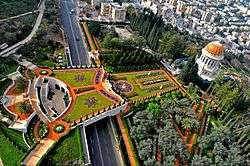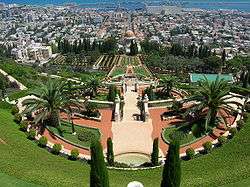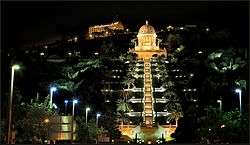Terraces (Bahá'í)




The Terraces of the Bahá'í Faith, also known as the Hanging Gardens of Haifa, are garden terraces around the Shrine of the Báb on Mount Carmel in Haifa, Israel. The gardens rest in the neighborhoods of Wadi Nisnas and Hadar HaCarmel. They are one of the most visited tourist attractions in Israel. The architect was Fariborz Sahba of Iran and the structural engineers were Karban and Co. of Haifa. Along with the Baha'i Holy Places in Western Galilee, it is a UNESCO World Heritage Site.
Symbolism
The terraces represent the first eighteen disciples of the Báb, who were designated "Letters of the Living",[1] although no individual terraces are connected with individual Letters.[2]
Design
Nine concentric circles provide the main geometry of the eighteen terraces. Just as the identification of a circle presupposes a centre, so the terraces have been conceived as generated from the Shrine of the Báb. The eighteen terraces plus the one terrace of the Shrine of the Báb make nineteen terraces total. Nineteen is a significant number within both the Bahá'í and Bábí religions.
Fariborz Sahba began work in 1987 designing the gardens and oversaw construction. The terraces were opened to the public in June 2001.[3] Beginning at its base, the gardens extend almost one kilometre (0.6 miles) up the side of Mount Carmel, covering some 200,000 square metres (2,152,782 square feet) of land. The gardens are linked by a set of stairs flanked by twin streams of running water cascading down the mountainside through the steps and terrace bridges.[4]
The gardens have elements of the Persian paradise gardens, isolating the site from the noise of the surroundings and connecting the different Bahá'í buildings on Mount Carmel together.[5]
Water and ecology
The irrigation system includes a computer which, based on meteorologic data it receives, controls hundreds of valves to distribute water throughout the gardens by sprinkling and dripping. This is done at night and in the early morning, to avoid wasting water by evaporation. The water that flows alongside the stairs is circulating in a closed system within each terrace, so that little water is wasted.[6]
See also
References
- ↑ Info.bahai.org: The Projects on Mount Carmel
- ↑ UHJ letter: Letters of Living; Dawn-Breakers; Quddus; Terraces
- ↑ Momen, Moojan (2009). "Bahá'í World Center". Bahá’í Encyclopedia Project. Evanston, IL: National Spiritual Assembly of the Bahá’ís of the United States.
- ↑ Gardens of Worship: Recreating Eden (season 3, episode 30, 2006) Archived 2012-03-01 at the Wayback Machine.
- ↑ Yael Hammerman: Distinctive Design of the Bahá’í Gardens
- ↑ Bahá'í World Centre: Environmental Considerations in the Bahá’í Gardens
External links
| Wikimedia Commons has media related to Bahá'í Terraces. |
- "The Bahá'í Gardens - Official Website". Bahá’í World Centre. 2009-03-20.
- "BahaiPictures.com - A Comprehensive Collection of Photographs of the Bahá'í Terraces and Gardens". 2009-12-27.
- "Haifa's Majestic Bahai Gardens - A UNESCO World Heritage Site". Israel News. 2009-03-31. Archived from the original on 2008-12-02.
Coordinates: 32°48′52″N 34°59′13″E / 32.81444°N 34.98694°E